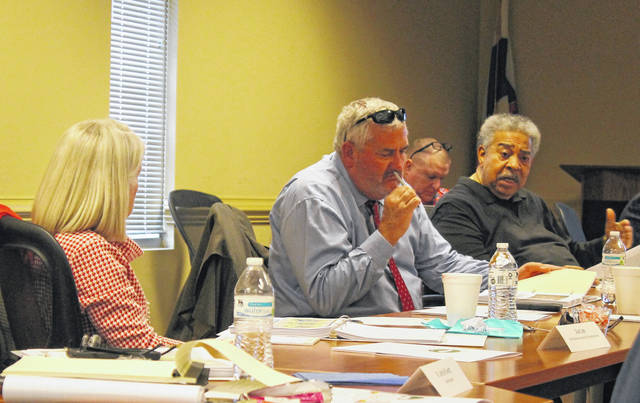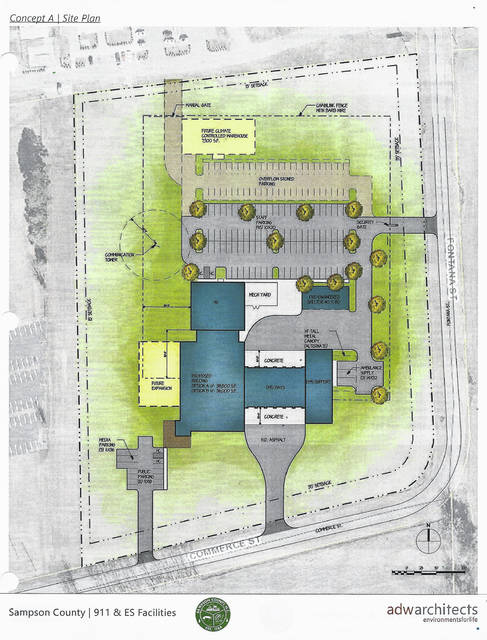County officials have agreed to pursue an option for a new Sampson County Emergency Management Services facility that will cost an estimated $17.8 million, with a key caveat that if the grant funds aren’t there to support the project, then a followup meeting at the drawing board will have to be held to regroup and revise.
ADW Architects of Charlotte, whose hire was approved by the Sampson Board of Commissioners at the beginning of this year, offered four options for the new facility during a recent county planning session. The new emergency headquarters is deemed a necessity to replace the aging and outgrown facility on Underwood Street that was constructed in 1956.
Option A included Emergency Management, EMS, E-911 and the Fire Marshal’s Office, with 38,777 square feet in total space. Of that, Emergency Management accounts for 6,386 square feet, EMS has 14,538 square feet, E-911 totals 8,794 and the shared space accounts for the remaining 7,299.
Option B likewise included Emergency Management, EMS, E-911 and the Fire Marshal’s Office, with 36,313 square feet in total space. Of that, Emergency Management accounts for 6,515 square feet, EMS has 13,652 square feet, E-911 totals 7,605 and the shared space accounts for the remaining 6,781.
Option C does not include EMS, lopping off a significant portion of the building, which under the option would tally just over 20,000 square feet, with Emergency Management, E-911 and the Fire Marshal’s Office all being the same size as they were in Option B. The shared space would be 4,396 square feet.
Option D would include only 911, the building totaling just 8,528 square feet.
As the building decreases in size and accommodations, the cost follows. According to ADW Architects, the total project cost for Option A is estimated at roughly $19.6 million. Option B comes in at about $17.7 million, while Options C and D are estimated at $14.8 million and $8.8 million, respectively.
The board ultimately settled on Option B. While no formal vote was taken, the five board members concurred to move forward.
“I have somewhat mixed feelings about this,” said Commissioner Harry Parker. “If I had to choose, I’d choose (option) A due to the fact that if we come back to that situation, it’s going to cost us more in the long run to add on to those areas. EOC, E-911 and everything else is right on top of each other — that doesn’t work too good. I used to work down there and I’ve experienced a few things down there.”
Parker pointed to the importance of investing in the project.
“That is as much a part of county government as any other building we have here,” said Parker.
Finance officer David Clack said the county — factoring in $9 million in grant funds — would be looking at borrowing around $8.5 million for Option B, amounting to about $420,000 a year for a USDA 30-year loan, at more than 10 percent interest.
For an $8.5 million bank loan, the county would likely get a 15-year option at 3 percent interest, which would put the county paying annual installments of $825,000, an amount that would decrease over the years until the final payment of roughly $584,000 in year 15, Clack noted.
Even talking grant funds, county officials said nothing is a given.
“This is just getting a general bill for the total project we can do,” Clack said. “If we’re pursuing — which doesn’t mean we ultimately have to do it — but if we’re pursuing a $17.5 million project, that’s what we want to be able to communicate with USDA, with Golden LEAF and see what will come out of those inquiries.”
Clack said there is always the likelihood of more grant funding being available, but that won’t be known until an real scope of the project is made available.
“That will go a long way (to offset costs),” Clack said of any additional grants. “We are not asking for a blank check to say we’re going to borrow the difference no matter what it is to build this.”
In January, the board authorized staff to negotiate and execute the contract for services with ADW Architects, with a construction contract not to exceed $10.5 million. A previous $7 million estimate was received in early 2019, however engineers and local leaders said that estimate was rough.
That jump of $3.5 million — from $7 million to $10.5 million — has now turned into a leap to more than $17 million. County leaders said they aren’t taking the jump blindly, or without a safety net.
The county previously received $3.5 million in North Carolina Office of State Budget and Management (NCOSBM) funding, which will be expended first, according to the timeline. Those millions in state grant funds were formally accepted in November 2019 to build the revamped emergency headquarters in the county.
A timeline for the EMS project has the project being bid out in the fall of 2020, with work set to begin in October. Construction is likely to take 15-18 months, officials have said.
“At this point in time, it might be helpful for the board to decide what you want to do,” Causey said leading up to the board’s recent consensus for Option B. “Let’s just say we get down the road and our funding is limited, and we have to cut the project way back. The biggest expenditure we have at that point is the developmental cost, the architectural fees…”
If the county opts out due to insufficient funds, it may be able to recoup some of the costs that went into plans for the more ambitious construction options, Causey noted.
“We’re going to draw up a B, and if that doesn’t work we’re going to make it a C or a D?” Chairman Clark Wooten confirmed. Causey said that would be the plan.
Commissioner Thaddeus Godwin said he felt B was the best option. Parker stuck to A, but said he could go with the group on B.
“The terminology is ‘pursuing,’” said Commissioner Jerol Kivett. “I am willing to pursue B.”
Two more detailed cost estimates will be forthcoming, ADW architects said.
“We have concurrence,” said Wooten. “We’re going to pursue B.”
The proposed facility would be situated in the bend on Commerce Street off of U.S. 701 Business in Clinton, between Sampson-Bladen Oil Company and the Sampson County Law Enforcement Center. The county owns 22 acres on both sides of Commerce Street that has not yet been developed.
While the idea for a new facility has been tossed around for years, emergency officials said the building has become too small and is susceptible to flooding during even moderate rains. The facility served as a North Carolina National Guard Armory until it was released to the county in 1995. There is a general lack of space for staff, equipment and storage, as well as ventilation issues.
Sampson County Emergency Management director Ronald Bass has noted the old armory building is “in dire need” of replacement.
“The space is kind of secondary to the flooding issue,” Bass said during the planning session.



